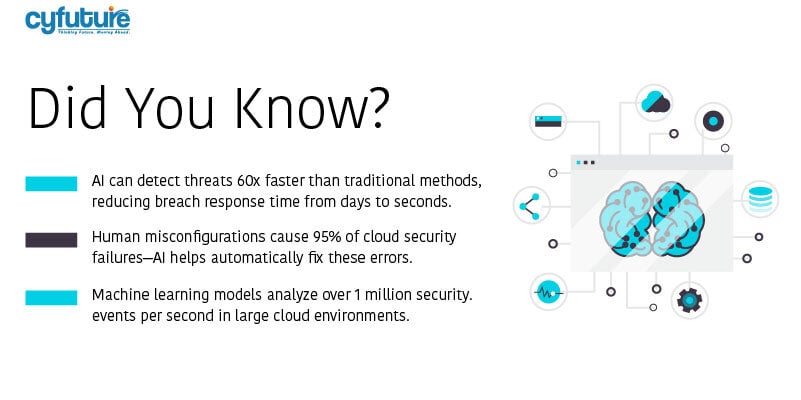-
Get Cloud GPU Server - Register Now!
Toggle navigation

Security remains a key concern for companies in the quickly changing terrain of cloud computing. The complexity of security concerns rises in line with the increasing acceptance of clouds. Artificial intelligence (AI) and machine learning (ML) help to solve these complex concerns for which conventional security solutions often fall short. By means of proactive threat detection, automated response systems, and improved threat information, these technologies are transforming cloud security.
The important part artificial intelligence and machine learning play in Cloud Security Services will be discussed in this paper, together with how they are changing the way companies defend their cloud environments.
Among the several advantages of cloud computing are scalability, adaptability, and cost economy. But it also presents special security issues. Because cloud systems are large and dynamic, conventional security tools find it challenging to keep up with changing threats. The sheer volume of data and the complexity of cloud systems call for modern solutions to monitor, identify, and handle security events properly.

By automating threat detection, raising accuracy, and shortening incident response procedures, artificial intelligence and machine learning (ML) greatly increase the efficiency of cloud security response times. These are the main ways artificial intelligence and machine learning improve the reaction efficiency of cloud security:
Real-time analysis of enormous volumes of data by artificial intelligence and machine learning techniques can help to spot possible hazards. Learning from past data helps these systems to identify fresh risks and adapt to changing conditions, therefore enabling proactive detection and response.
For security teams, excessive numbers of false positives produced by conventional security systems can be time-consuming and aggravating by analyzing data more precisely, artificial intelligence and machine learning lower false positives and free teams to concentrate on actual risks and react more quickly.
Once hazards are identified, artificial intelligence and machine learning can set off automated systems to stop harmful behavior and start recovery initiatives. By reducing human involvement and mistakes, this automation guarantees quicker response times and less possible damage.
By means of previous data, ML models may forecast future attack trends, therefore empowering companies to engage in proactive security practices. By means of preparation for possible hazards, this predictive capacity improves the general security posture and lowers response times.
As cloud environments expand, artificial intelligence and machine learning can scale with the handling of rising data volumes and complexity without sacrificing speed. This scalability guarantees that, even as cloud resources grow, security precautions stay efficient.
Through user behavior tracking and questionable action identification, artificial intelligence and machine learning improve authentication and access management. These systems can modify access control policies to lower illegal access risks, therefore enhancing response times by avoiding the materialization of threats.
Automation driven by artificial intelligence aids in vulnerability management, incident response, and triaging of alarms. Faster processing of event data by AI algorithms than by human operators helps to resolve problems and reduces possible damage.
By automating detection and response, lowering false positives, and strengthening predictive capabilities, artificial intelligence and machine learning generally help to enhance cloud security response times. These solutions help companies to react more effectively to security events, therefore safeguarding cloud environments against developing hazards.
By means of proactive threat detection, automated response systems, and improved threat intelligence, artificial intelligence and machine learning (ML) are revolutionizing cloud security. These actual applications of artificial intelligence and machine learning in cloud security:
By means of network traffic, user behavior, and application performance analysis, artificial intelligence and machine learning algorithms can find trends and anomalies suggesting possible hazards. Learning from past data helps these systems to identify deviations from typical behavior, therefore allowing security teams to react early to possible assaults.
Example: A corporation watches network traffic using ML in order to find odd trends suggestive of a DDoS attack. When abnormalities are found, the system sets off alarms to demand more research.
AI and ML can look for hazards that could have escaped notice using more traditional security protocols. ML systems can find suspicious activity across the network that might point to possible danger by means of data analysis, therefore enabling security personnel to probe and react more precisely.
For instance, a company examines logs using AI-driven threat-hunting technologies to find a hitherto unidentified malware variant. The AI system notifies the security staff, who then start a reaction to limit and lessen the threat.
Through user behavior tracking and questionable action identification, AI and ML technologies improve access control and authentication. Constant learning from user behavior patterns allows these systems to modify access control policies to lower illegal access risks.
For instance, a cloud service provider tracks user attempts to log in using artificial intelligence. Should a user show odd behavior—such as accessing private data from a foreign location—the AI system triggers further authentication processes like multi-factor authentication.
Data collecting and interpretation of threat intelligence can benefit much from artificial intelligence and machine learning. By compiling data from several sources, they help companies spot fresh vulnerabilities and flaws, therefore allowing them to create proactive security plans and react fast to possible hazards.
Example: An AI-powered system spots a fresh kind of phishing effort and changes security policies across cloud-based systems to stop possible data leaks and infections.
Reducing human mistakes and accelerating response times helps AI and ML to automate security operations. AI-driven systems, for example, can examine logs linked with security events, cross-reference them with known threat indicators, and start incident response activities without human involvement.
For instance, a corporation automated security log analysis using artificial intelligence. The AI technology isolates impacted resources and alerts the security team when suspicious behaviour is found, therefore guaranteeing a quick reaction to possible hazards.
AI tools may automatically examine cloud infrastructure for anomalies and improperly configured settings and then rectify them. In complicated cloud systems where hand detection and remedial action are time-consuming and prone to mistakes, this automation is absolutely vital.
For instance, a company searches its cloud architecture for improperly configured resources using artificial intelligence. The AI system automatically fixes a configuration that can reveal private information, therefore averting possible security leaks.
Large databases allow artificial intelligence algorithms to find odd access trends human operators would overlook. Based on elements such as user roles, access rights, and network traffic patterns, this ability improves security issue detection.
For instance, a corporation tracks user behavior via its cloud-based offerings using artificial intelligence. Should a user access materials beyond their regular purview or from an odd location, the AI system notes this behavior for more inquiry.
These use cases show how, by offering proactive, quick, efficient answers to difficult security problems, artificial intelligence and machine learning are transforming cloud security.

Future developments in artificial intelligence and machine learning (ML) for cloud security center on strengthening security measures, raising efficiency, and tackling newly arising risks. These important trends and advancements will help to define cloud security in the future:
Real-time threat detection and response will depend much on artificial intelligence and machine learning. These devices will become more powerful, using cutting-edge algorithms to spot intricate risks and run response systems automatically. AI-driven systems will, for example, examine user behavior and network traffic to forecast any hazards before they become apparent.
By addressing difficult challenges that conventional systems cannot manage, quantum computing is supposed to improve cloud security. More strong encryption techniques and powerful threat analysis tools resulting from this integration will help to guarantee that cloud environments stay safe against upcoming risks.
GenAI is poised to revolutionize cloud security by offering guidance and assistance to human practitioners. It will help process complex data quickly, allowing for more informed decision-making and enhanced security postures. GenAI will also simplify cloud engineer roles by automating security controls and integrating them into cloud infrastructure.
Reactive security measures will give way to proactive ones. By spotting flaws and misconfigurations before they are used, artificial intelligence and machine learning will help to forecast and stop breaches. This proactive strategy will minimize any damage by means of real-time monitoring and automated response systems.
Threat actors will use artificial intelligence algorithms to launch advanced attacks as AI is more common. Organizations responding must make investments in defensive artificial intelligence capabilities if they are to remain ahead of these challenges. This covers creating countermeasures driven by artificial intelligence to identify and stop AI-based assaults.
Green cloud solutions—which center on energy-efficient data centers run on renewable energy—will get more and more importance. This trend lessens the environmental impact of cloud computing and fits more general sustainability objectives.
AI and ML will be very important in managing these complicated configurations as hybrid and multi-cloud systems proliferate. While preserving strong security across many cloud platforms, they will assist in guaranteeing flawless integration and scalability.
Future advancements in artificial intelligence and machine learning for cloud security are essentially driven by enhanced threat detection, proactive security measures, integration with developing technologies like quantum computing, and smart countermeasures addressing the changing threat scene.
Providing proactive threat detection, automated response systems, and improved threat intelligence, artificial intelligence, and machine learning are transforming cloud security. Maintaining a safe cloud environment in the face of changing cyberspace requires these technologies. Integration of artificial intelligence and machine learning will remain essential as cloud computing expands to guarantee the integrity and security of cloud-based data and applications.
Leading provider of data center and cloud services, Cyfuture India Pvt LTD, provides a range of solutions catered to fit changing needs of companies. Emphasizing dependability, scalability, and security, Cyfuture guides companies toward using cloud computing’s advantages while guaranteeing strong security systems are in place.
Recommendations for Businesses